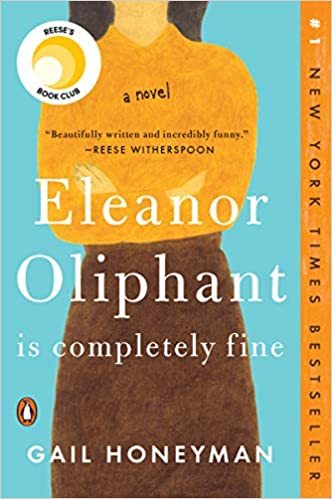From a Good Heart and a Great Pen: Honeyman’s Eleanor Oliphant

Even though this book has been out for four years and reviewed many times (I’ve read none of them), it’s new to me, and I want to sing its praises. It does have a few flaws, but they are minor in contrast with its virtues. There’s a very dark element—something horrendous has happened—that will thread throughout, be clearly exposed and understood, but it’s balanced and actually overwhelmed by quirky characters, good people, and good warm messages. While entertaining from beginning to end, it fosters understanding of how very different we are in our interpretation of what’s normal, standard, and even what’s happening at a given moment. And it illustrates that being open to experience and interacting with others may be awkward and painful, but it’s the road to knowing who you are.
Eleanor Oliphant (not her real name) is Scottish, works as an accountant in the back office of a company. She has four immediate coworkers, but others interact occasionally. Eleanor is disfigured with a scarred face, and the cause of the disfigurement haunts her in brief memories. Her upbringing has prepared her for a certain kind of “normal” and a certain place in the world. From her point of view what she does is the proper way, but to those around her, she is perhaps “right nutty.” She has lived in the same apartment for about 10 years, with no visitors, no social life. She has frequent conversations with her verbally vicious mother, and weekend visits with a bottle of vodka. Though isolated, she knows of popular culture and trends, though only generally, beauty shops, bikini waxes. Recently, she has set her heart on musician Johnnie Lomond, whom she hasn’t met, as the man who will be her life partner—her savior. While she’s trying to reinvent herself to capture his interest, she’s being courted by a kind of oversized nice guy coworker, Raymond, from IT.
Eleanor is a very quirky character, and very winning. Articulate, intelligent, judgmental, occasionally biting, she can switch dialects and verbal domains (talk high society or low, British or Scots), and seems familiar with philosophy, literature, French—enough for light social discourse. One wonders how she came by this training. And one learns. Her innocent anticipation about such matters as bikini waxes, hair styling, and especially about food are humorous and possibly match many of our own awkward introductions into a culture, sub or main.
At times realism is stretched. At the beginning, Eleanor’s physical disfigurement appears to be a major disfigurement, not so later on, manageable with makeup. Some of Eleanor’s insight and consequent changes occur too swiftly. They outstep development, especially for a person as rigorously locked in a pattern as she seems to be. The quickness, though, keeps the story lively, and unpredictable. And there’s the possibility that she changes quickly because her core nature, under training and experience, is ready to burst out with the first opportunity and sense of safe landing.
The mystery of what happened to Eleanor—and her role in it–unwinds a little at a time and is never the real draw, just one part. That’s refreshing, letting the reader know or at least suspect that this isn’t going to be a graphic horror. Horror, yes, in the sense of what happens to people in life, but not scene to scene depicted. In fact, it’s a kind of gentle mystery, not a cozy, but like a British mystery where the crime is vile, but the people are the reward of the book, quirky, but basically good. The mystery is honestly answered. There’s no surprise, and a reader accustomed to mysteries will likely identify the clues—not be able to project totally, but to feel on a good track, and at the end say Aha!
The language is particularly appealing. Some passages are so perfect to that character and her world, and yet, one may want to adopt them. Eleanor explains that when she wants to know something, she relies on the animal world, and might ask herself “What would a salamander do?” If we consider that a bit deeply, she’s saying she has to rely on what she knows. Which is what she does. Perhaps we all do. Here are a few examples from many that are immediately touching. Describing herself: “I am matte dull and scuffed.” Upon seeing a crying baby finally being comforted: “My heart soared for him.” And at a certain moment: “Silence sat between us, shivering with misery.” Such lines at the right time are so valuable to readers, at least this one. I like to feel the story as well as to read and know it.
This was Gail Honeyman’s first book. I look forward to any writing from her good heart and great pen.
Eleanor Oliphant is Completely Fine: a Novel
Penquin 2017, 2018
Available on Amazon and everywhere else



